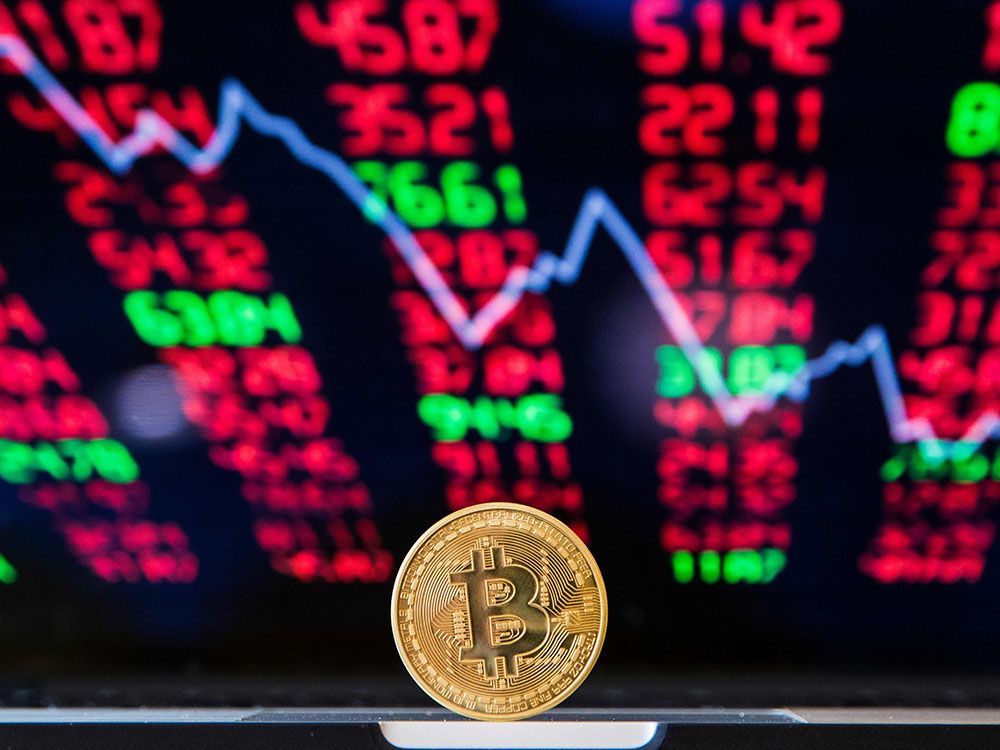
Volatility in bitcoin prices now explains 14% of the volatility in the S&P 500
Article content
By David Rosenberg and Vibhu Kapoor
Advertisement 2
Article content
The recent fall in the price of stablecoins — a type of cryptocurrency whose value is backed by another stable asset such as the USD, gold, commercial paper, etc. — has rattled investors in the already reeling cryptocurrency market.
These stablecoins are designed to maintain a one-to-one peg with the United States dollar, but last week, two of the most popular ones — tether and terra — traded as low as 95 and 23 cents U.S., respectively. The former has regained its peg while the latter is now down to eight cents U.S.
Even though these coins are relatively small (combined US$80 billion in size) when compared to the market cap of some publicly traded companies, their growing popularity and rapid integration with the global financial system means that this sort of de-pegging event can potentially wreak havoc in the entire cryptocurrency space, which could eventually spill over to traditional financial markets.
Why are stablecoins so popular? Traders can use normal dollars to purchase crypto tokens such as bitcoin and ether. However, the settlement takes time, and the price of these cryptocurrencies is highly volatile. So instead, they use traditional currencies to purchase stablecoins, which are accepted on crypto exchanges. That allows traders to quickly purchase and sell other digital assets. But the central reason behind the popularity of these stablecoins is the one-to-one peg with the U.S. dollar that is fully backed by some sort of reserves.
Advertisement 3
Article content
Now, the type of reserves depends on the type of stablecoin. In the case of tether, it is backed by cash or cash-equivalent reserves — commercial paper, fiduciary deposits, case, reverse repo notes and treasury bills, according to the company. On the other hand, terra is an algorithmic stablecoin whose value is propped up by another cryptocurrency. There is no need to get into the nitty gritty of how it works, but in this specific case, bitcoin was being used to defend the peg as a measure of last resort.
Last week, terra underwent something similar to a bank run, which prompted a wave of selling. In order to maintain its peg with the U.S. dollar, its creators sold more than US$3 billion of bitcoin, which contributed to the sharp drop in the digital token’s price — touching as low as US$25,000 before recovering to the current US$29,000 mark (it is down 56 per cent from last November’s peak).
The slump in terra’s price also spilled over to other stablecoins such as tether, which also briefly lost its peg with the dollar (going as low as 95 cents U.S. before recovering to the US$1 benchmark). Terra may have directly contributed to a selloff in bitcoin, but the bigger problem lies with tether, which is by far the largest stablecoin (nearly 50-per-cent market share).
Let’s assume that if tether were to lose its peg with the U.S. dollar for a prolonged period of time, its holders would begin cashing out in order to stem their losses. In turn, to maintain the peg, tether’s creators will have to sell their reserves (such as commercial paper, T-bills, etc.), and that could disrupt major traditional markets. And the bigger tether gets, the greater this financial stability risk becomes.
Advertisement 4
Article content
Given that the entire cryptoverse is highly interconnected, the volatility from stablecoins (coming from a de-pegging event) will spill over into bitcoin and ether. Since these two coins trade like just another speculative asset (rather than a hedge) — they command a near 50-per-cent correlation with U.S. equities — it’ll be no surprise if heightened volatility in cryptocurrencies affects equity markets as well.
Indeed, a recent financial stability note from the International Monetary Fund quantifies it. Using a vector autoregressive model, the author finds that the volatility in bitcoin prices now explains 14 per cent of the volatility in the S&P 500. Further, eight per cent of the variation in the S&P 500’s daily returns can be explained by bitcoin. The results are similar in magnitude and direction for the Nasdaq and Russell 2000.
This is a significant result because pre-pandemic, the contribution of crypto assets in explaining the variations in equity markets was barely one per cent. The increased integration between the two asset classes can most likely be attributed to the newfound interest from retail and institutional investors.
There is no denying that cryptocurrency is here to stay (and might even provide some long-term benefits). However, events in recent weeks show that it is neither safe nor a haven and instead poses much greater financial stability risks. The rising use of leverage in its trading and highly volatile prices reiterate the argument that it cannot be regulated with a light touch approach anymore and, as such, its oversight needs to be strengthened.
David Rosenberg is founder of independent research firm Rosenberg Research & Associates Inc. Vibhu Kapoor is an economist there. You can sign up for a free, one-month trial on Rosenberg’s website.
_____________________________________________________________
If you like this story, sign up for FP Investor Newsletter.
_____________________________________________________________
This news is republished from another source. You can check the original article here



